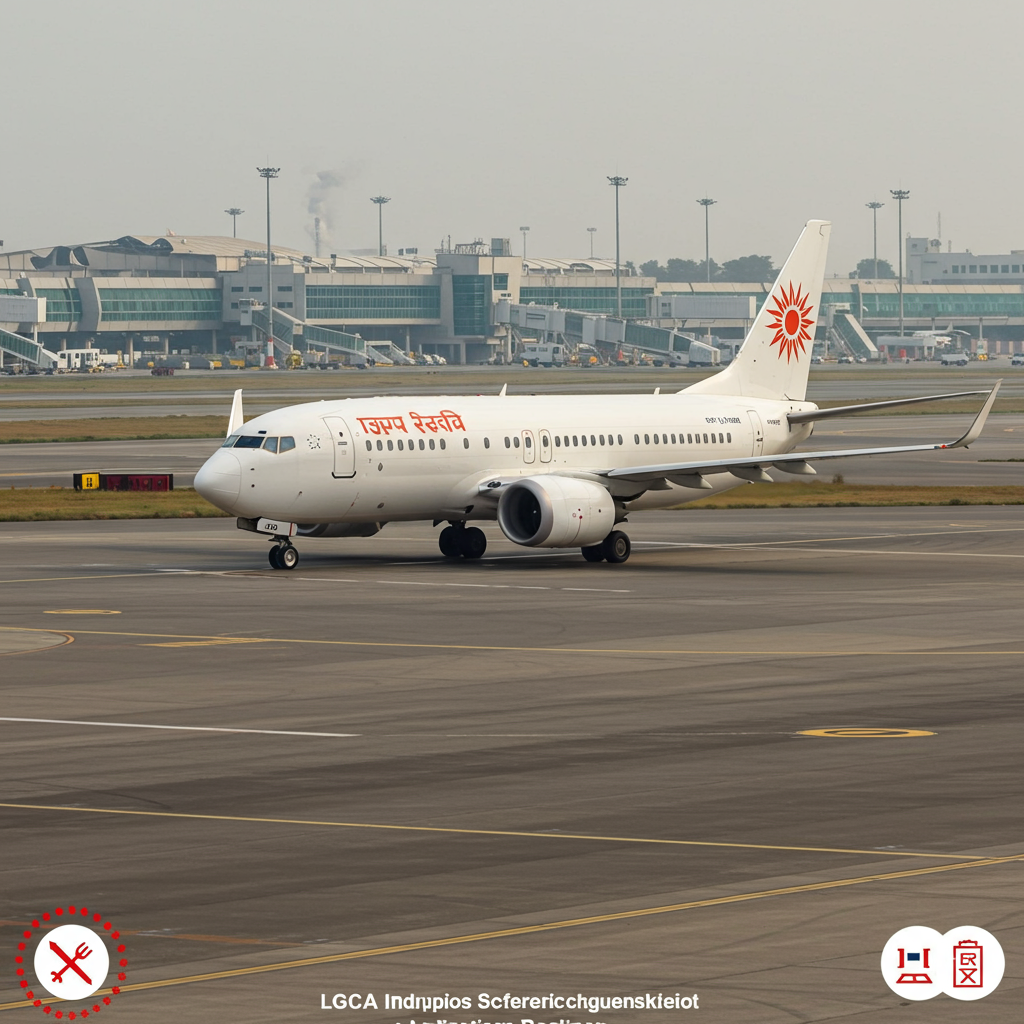Aviation safety is paramount, and regulators worldwide continuously adapt measures based on investigation findings. Following a tragic Air India crash in June that claimed 260 lives, India’s aviation watchdog has issued a vital directive impacting all domestic airlines operating Boeing aircraft. This order mandates immediate inspections of fuel control switches, a critical component thrust into the spotlight by the preliminary accident report.
The move by the Directorate General of Civil Aviation (DGCA) underscores heightened scrutiny on specific aircraft systems after the crash of London-bound Flight 171, a Boeing 787 Dreamliner. While preliminary reports don’t assign blame, they pinpoint facts that necessitate action. This mandatory inspection goes beyond previous recommendations and reflects a proactive stance from Indian authorities amidst international reactions and ongoing investigations.
India Mandates Fuel Switch Inspections on Boeing Fleet
India’s aviation regulator, the Directorate General of Civil Aviation (DGCA), has ordered all airlines operating in the country to carry out inspections of fuel control switches on their Boeing aircraft. This includes popular models like the Boeing 787 Dreamliner and Boeing 737 variants flown by major Indian carriers. The directive follows a preliminary report into the fatal Air India crash that occurred last month.
The DGCA has set a strict deadline of July 21st for these inspections to be completed. The regulator emphasized that “strict adherence to the timeline is essential to ensure continued airworthiness and safety of operations.” This mandatory order significantly raises the stakes compared to earlier, non-binding advisories regarding these specific components.
The Tragic Context: Air India Flight 171 Crash
The DGCA’s urgent directive is a direct response to the preliminary findings surrounding the crash of Air India Flight 171 on June 12th. The accident, involving a Boeing 787-8 Dreamliner shortly after takeoff, resulted in the deaths of 260 people, marking one of the worst aviation incidents in years.
The preliminary report, published by the India Aircraft Accident Investigation Branch (AAIB), highlighted a critical event that occurred moments after the aircraft lifted off. It found that fuel flow to both of the jet’s engines was cut off. The report indicated that the switches controlling this fuel flow had been moved from the standard “run” position to the “cut-off” position.
Preliminary Report Findings and Cockpit Focus
The AAIB’s initial investigation focused heavily on the cockpit environment and the state of the aircraft’s controls during the critical phase of flight. The preliminary report included chilling evidence from the cockpit voice recording.
According to the report, one pilot was heard asking the other, “why did you cut off?”. The second pilot reportedly denied taking this action. While the report explicitly states its purpose is “not to apportion blame or liability,” this finding immediately directed scrutiny towards the cockpit fuel control switches and the actions, or inactions, of the flight crew.
Understanding Aircraft Fuel Control Switches
Fuel control switches are vital components in an aircraft’s cockpit, managing the flow of fuel from the tanks to the engines. On Boeing aircraft, including the 787 and 737, these switches are typically located prominently, often near the thrust levers. They are designed with a locking feature that usually requires the switch to be lifted before it can be moved to the ‘cut-off’ position, preventing accidental activation.
Pilots use these switches primarily at the end of a flight to shut down the engines or in emergency situations requiring fuel cutoff. The locking mechanism is a key safety feature intended to ensure the switches remain in the ‘run’ position during flight unless deliberately moved by the crew.
The 2018 FAA Advisory and Air India’s Action
The preliminary report on Flight 171 also referenced a 2018 advisory from the US Federal Aviation Administration (FAA). This advisory had recommended – but did not mandate – that operators of certain Boeing models, including the 787, inspect the locking features on their fuel cut-off switches.
The FAA’s 2018 bulletin was prompted by reports of disengaged locking features on some Boeing 737 models, though it did not deem this condition unsafe for continued flight. The AAIB’s preliminary investigation noted that Air India had not performed the inspections suggested by this 2018 FAA advisory because it was not a mandatory requirement at the time.
Regulatory Divergence and Global Reactions
India’s mandatory order for inspections stands in notable contrast to recent statements from Boeing and the US FAA. On the same day India issued its directive, the FAA reiterated its stance that fuel control switches on Boeing aircraft are safe. The FAA also commented on its 2018 advisory, stating it was based on reports of switches installed with locking features disengaged, but maintained this did not make the planes unsafe.
Despite the assurances from the US regulator and manufacturer, India’s DGCA has clearly taken a more cautious approach, making the checks mandatory. This divergence highlights the different levels of concern and regulatory responses triggered by the preliminary crash findings.
South Korea and Other International Responses
India is not alone in taking action following the report. The Reuters news agency reported that South Korea is also preparing to order its airlines operating Boeing jets to conduct similar examinations of fuel switches. South Korea’s planned checks are reportedly aligned with the details mentioned in the 2018 FAA advisory referenced in the preliminary report.
Beyond governmental orders, some airlines themselves have already begun conducting checks. Air India Group started inspecting the locking mechanisms on its own Boeing 787 and 737 fleets over the weekend preceding the DGCA’s order. Reports indicated that checks on a significant portion of their fleet were completed with no issues found, demonstrating proactive internal safety measures. Other global carriers, like Japan Airlines (JAL), are also closely monitoring the investigation and are prepared to implement necessary inspections based on further findings.
Speculation, Pilot Defense, and Expert Views
The preliminary report, while factual, has fueled considerable speculation regarding the cause of the fuel cutoff. Two main theories have emerged in public discussion: potential pilot error or intentional action versus a mechanical failure or issue with the fuel switch locking mechanism itself.
The Indian Commercial Pilots’ Association has strongly defended the crew of Flight 171. They released a statement asserting that the pilots “acted in line with their training and responsibilities under challenging conditions” and urged that they “shouldn’t be vilified based on conjecture.” The association specifically condemned “reckless and unfounded insinuation of pilot suicide,” stating there is “absolutely no basis” for such claims at this stage.
Aviation experts have commented on the design of the switches, noting their central location and the deliberate action required to move them past the locking feature. They suggest that accidentally moving both switches simultaneously would be highly unusual, particularly during the critical takeoff phase below 1,000 feet. Air India CEO Campbell Wilson also cautioned against premature conclusions in a memo to staff, stating the preliminary report “identified no cause nor made any recommendations” and that the investigation is “far from over.”
Impact on Airline Operations and Passengers
The DGCA’s mandatory inspection order, with its tight deadline of July 21st, is expected to have some impact on airline operations in India. Carriers operating significant fleets of Boeing 737 and 787 aircraft must schedule the necessary ground time to perform these checks.
While airlines are working to complete the inspections efficiently, there could be potential for temporary grounding of aircraft, leading to delays or cancellations, particularly on routes served by these models. Passengers flying on affected aircraft in the coming days should monitor their flight status closely through airline communication channels. Airlines are expected to provide updates and manage disruptions to the best of their ability, potentially offering rebooking options. This regulatory action, though potentially inconvenient for travelers in the short term, is framed by authorities as a necessary step for ensuring long-term safety.
Ensuring Aviation Safety Through Vigilance
India’s swift and mandatory order for Boeing fuel switch inspections highlights the dynamic nature of aviation safety regulation. Learning from incidents, even through preliminary findings, prompts necessary action to mitigate potential risks across the fleet.
By requiring these checks, the DGCA aims to verify the proper functioning of the fuel switch locking mechanisms and address concerns raised by the Air India crash report. This proactive approach, aligned with similar considerations in other countries like South Korea, reinforces a global commitment to enhancing safety standards and responding decisively to potential vulnerabilities. Ultimately, such measures, though sometimes disruptive, are crucial steps in maintaining the high level of safety the traveling public expects and deserves, reinforcing trust in air travel.
Frequently Asked Questions
What did India’s aviation regulator order regarding Boeing jets?
India’s Directorate General of Civil Aviation (DGCA) has issued a mandatory order requiring all Indian airlines to inspect the fuel control switches on their Boeing 737 and 787 aircraft. The inspections must verify the proper functioning of the switches’ locking mechanisms to prevent accidental movement. Airlines have until July 21st to complete these checks and report compliance.
Why are airlines checking fuel switches on Boeing aircraft?
The mandatory inspections follow a preliminary report into the fatal Air India Flight 171 crash in June, which killed 260 people. The report indicated that fuel flow to the engines was cut off shortly after takeoff, and the fuel control switches were found in the ‘cut-off’ position. These inspections aim to ensure the critical locking features on these switches are functioning correctly based on concerns raised by the incident.
What does the Boeing fuel switch inspection order mean for air travel in India?
The order means airlines operating Boeing 737s and 787s in India must schedule ground time for inspections before the July 21st deadline. This could potentially lead to some temporary aircraft groundings, causing possible flight delays or cancellations. Passengers flying on these models in the immediate future are advised to monitor their flight status closely, as airlines manage operational adjustments to complete the mandated checks.



